Should Your Food Distribution Business Use FEFO Warehouse and Inventory Software?
Many food distributors rely on first-in, first-out (FIFO) for inventory management.
An alternative method is first-expired, first-out (FEFO), in which the products closest to expiration in your inventory are shipped first. FIFO is a simpler method, and is a more common capability of warehouse and inventory management software.
So, why should a food distributor make the switch to FEFO warehouse software?
The answer is simple: The retail landscape is changing, and consumers are demanding more information than ever about the food products they purchase.
In fact, our original consumer research shows that expiration dates crucially affect purchase decisions.
By giving your retail clients more lead time on the expiration dates of items you ship them, you can help them move more products—and boost the number of sales orders your business receives.
Here’s what our report will cover:
The Importance of Expiration Dates Goes Beyond Food Safety
Dynamic vs. Basic FEFO: What’s the Difference?
Most Consumers Inspect Expiration Dates While Shopping
Willingness to Purchase Items Drops as Expiration Dates Near
Consumers Mostly Use Expiration Dates to Measure Shelf Life
FEFO Critical for Distributors of Refrigerated Products & Bread
Distributors to Big Grocery/Retailers Can Benefit Most
The Importance of Expiration Dates Goes Beyond Food Safety
There are many benefits of using software with FEFO capabilities. After all, you need a solid business case for stepping up the complexity of your warehouse and inventory management systems.
And there’s one very compelling reason to consider software with better expiration and lot tracking capabilities: consumers’ purchasing habits.
How Expiration Dates Affect Consumer Interest
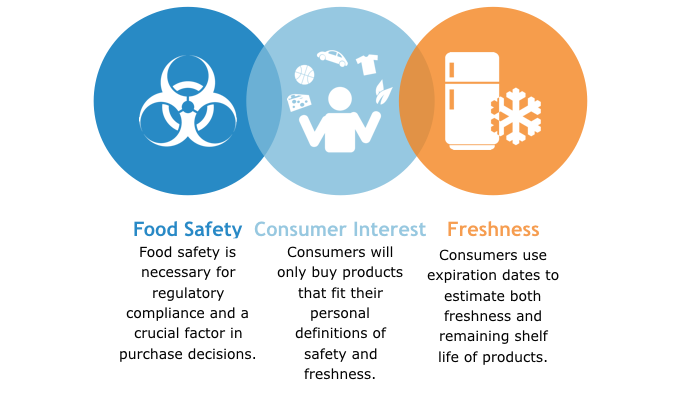
This visual shows that expiration date management is about more than just regulatory compliance. Expiration dates have different meanings for consumers than they do for the FDA.
Indeed, the key findings from our survey should be eye-opening for food distributors:
Impact of Expiration Dates on Consumers’
Shopping Decisions
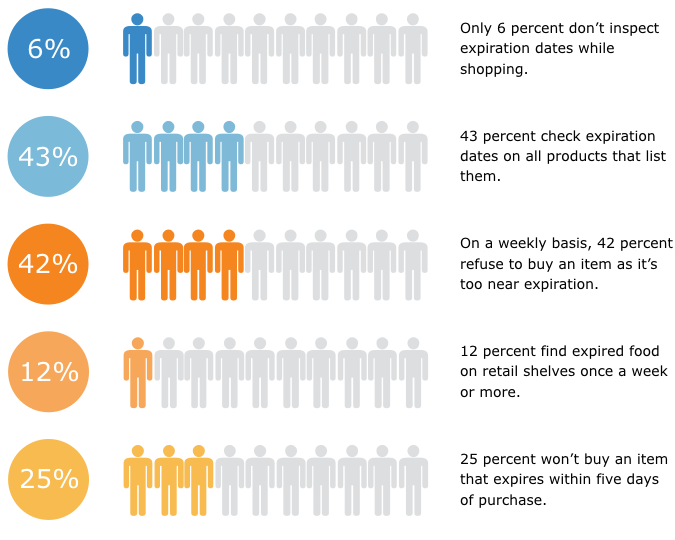
The findings from our survey show that expiration dates are more than just a food safety measure—they also play a crucial role in consumers’ shopping decisions.
Dynamic vs. Basic FEFO: What’s the Difference?
Of course, food safety is still mission-critical for distributors. The level of control you need over expiration dates will ultimately depend on the types of food you handle—so it’s important to remember that not all FEFO solutions are created equal. The term can refer to two inventory management methods with very different levels of technological complexity:
Dynamic FEFO systems (also known as “end-to-end” cold chain monitoring systems) can automatically generate and manage expiration dates for products using temperature readings from wireless sensors.
Basic FEFO systems associate expiration dates with lot numbers.
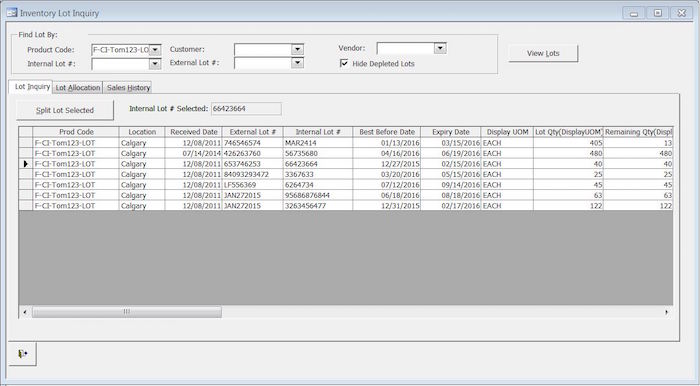
Lot numbers associated with expiration dates in BlueLink ERP
Dynamic FEFO is a complex, expensive technology. Wireless sensors must be installed in storage locations and trucks to continuously monitor the temperature levels products are exposed to.
This information then feeds into software that automatically calculates expiration dates for items using algorithms.
Because of the logistical challenges and expenses involved, dynamic FEFO systems are generally only used by distributors of frozen food, dairy products, fresh produce, meats and seafood. They’re also used in pharmaceutical and chemical cold chains.
Basic FEFO, however, is much more straightforward. The manufacturer or distributor assigns an expiration date to a lot, and the date remains associated with the lot number as the products move through the supply chain. Basic FEFO may be offered in:
Inventory management systems: These systems track expiration and lot information to indicate which items should be rotated out of inventory first.
Warehouse management systems (WMSs): These systems extend the use of FEFO by using it as a picking method, automatically directing workers to pick items closest to expiration first.
One important note: basic FEFO is not included in all inventory and warehouse management systems. Generally, only those systems capable of tracking lot numbers offer FEFO capabilities.
Dynamic FEFO is only offered by vendors specializing in cold chain technology that also sell the necessary wireless sensors.
To learn more about how lot tracking works with food distribution…
Read our guide on selecting the best lot tracking software.
Read our guide to inventory management systems and ERP suites that offer lot and expiration date tracking, including detailed pricing information.
Check out our feature comparison of warehouse management and ERP systems can help. It indicates which systems offer control over expiration dates.
Now, let’s turn to the research data to explore the impact of expiration dates on consumer behavior. As we’ll see, this can affect what type of software is right for your business.
Most Consumers Inspect Expiration Dates While Shopping
Many distributors fall into the trap of thinking that as long as a product has a few days of shelf life, retailers will be able to move it. However, a year of food scares—including the massive Blue Bell recall—has left consumers uneasy about food safety.
Indeed, our survey shows that nearly all consumers (94 percent) check expiration dates while making purchase decisions at the store:
Products Consumers Inspect Expiration Dates For
While Shopping
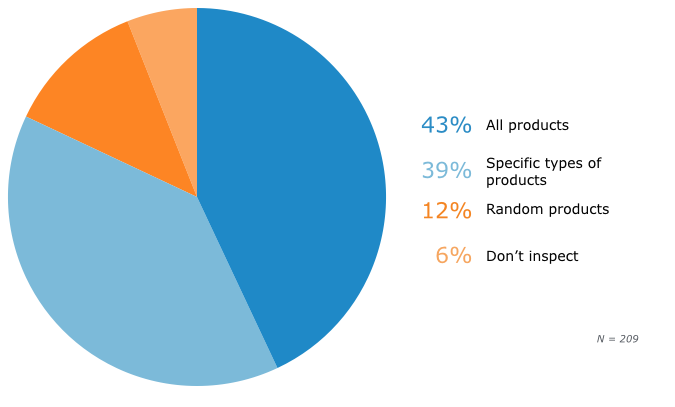
Perhaps the most striking trend we can observe in this chart is that nearly half of the consumers in our sample check expiration dates for all products, regardless of the type of food they’re buying.
Another 39 percent check dates for products in specific categories, such as fresh meat or seafood. (We screened out the 6 percent of our sample who don’t check expiration dates from the rest of our survey.)
This finding suggests that expiration dates are crucial in convincing consumers to purchase food items.
Willingness to Buy Items Drops as Expiration Dates Near
Indeed, we discovered that consumers who examine expiration dates also refuse to purchase products they perceive as being too close to expiration—and do so frequently.
How Often Customers Refuse to Purchase Products
Near Expiration
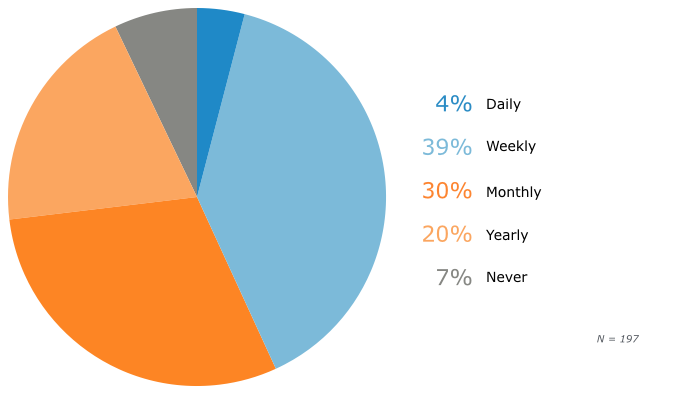
Only 4 percent report finding items too near expiration to purchase on a daily basis.
But when we add in consumers who find these items on a weekly basis, we see that nearly half our sample (43 percent) refuse to purchase an item based on its expiration date at least once a week.
What’s more, consumers find food that’s already expired on a regular basis:
How Often Consumers Find Expired Food in Stores
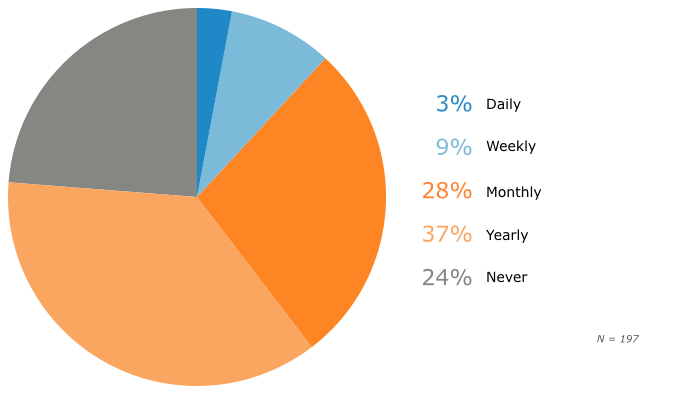
The fact that 40 percent of our sample find expired food on retail shelves at least once a month is cause for concern.
Of course, distributors can’t control how retailers manage inventory; removing expired products from shelves is, ultimately, the retailer’s job. But they can indirectly contribute to this problem by shipping items without enough lead time before they expire.
By using the FEFO method instead of FIFO, distributors can help ensure retailers receive products well in advance of expiration.
So, this begs the question: How much time before expiration is enough for consumers?
Remaining Shelf Life Necessary for Consumers
to Buy Food Items
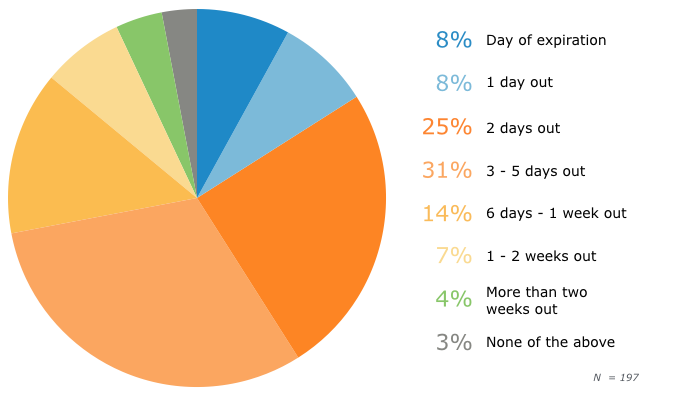
Just 8 percent of our sample are willing to purchase an item on its expiration date, and only a combined 16 percent will consider purchasing it within one day of expiration. Most consumers need at least three to five days of remaining shelf life in order to purchase an item, and one-quarter need even more time than this.
This finding suggests an important benchmark for using the FEFO method: Don’t assume items are “still good” up until the expiration date.
To gain a competitive edge, you should treat the item as if it were expiring three to five days before its printed expiration date. The item’s chances of being purchased drop dramatically if it remains on the shelf after this point.
By using FEFO rather than FIFO or another inventory management method, you can ensure you’re meeting consumer standards for food safety in addition to retailer and governmental standards.
Consumers purchase what they believe to be safe rather than what actually is safe.
However, it turns out that safety isn’t the only factor driving consumers’ practice of checking expiration dates on food products.
Consumers Mostly Use Expiration Dates to Measure Shelf Life
When we ask consumers why they check expiration dates, we find that food safety actually tends to be less important than the product’s remaining shelf life:
Reasons Why Consumers Inspect Expiration Dates
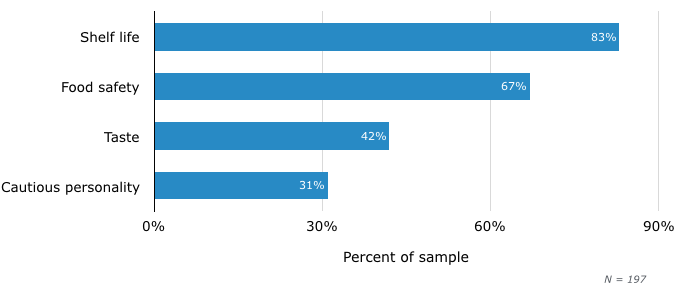
Nearly 83 percent of our sample view expiration dates as a value proposition, since these dates tell them how long food can remain on the shelf.
Thrifty consumers aren’t going to treat the issue of food waste in the same manner as a restaurant, where “wasting out” expired items is inevitable. If consumers aren’t buying the item for immediate consumption, its shelf life will be an important consideration for them.
This finding helps explain why so few consumers are willing to buy food items that will expire in three days or less. Many consumers don’t plan to consume the items they purchase immediately, so they need more lead time after purchase.
Another interesting finding from the above charts: Consumers use expiration dates to judge the taste of food products. Forty-two percent of our sample assume that products further from expiration “taste better” than products closer to expiring.
FEFO Critical for Distributors of Refrigerated Products & Bread
The decision to switch from less sophisticated inventory management methods to FEFO will, in many cases, require you to purchase inventory and/or warehouse management software.
Since not all distributors have the time, money or personnel for such a project, we’ve identified which types of organizations can benefit most from the FEFO method.
As it turns out, the importance consumers assign to expiration dates varies widely by food type:
Food Types Consumers Inspect Expiration Dates For
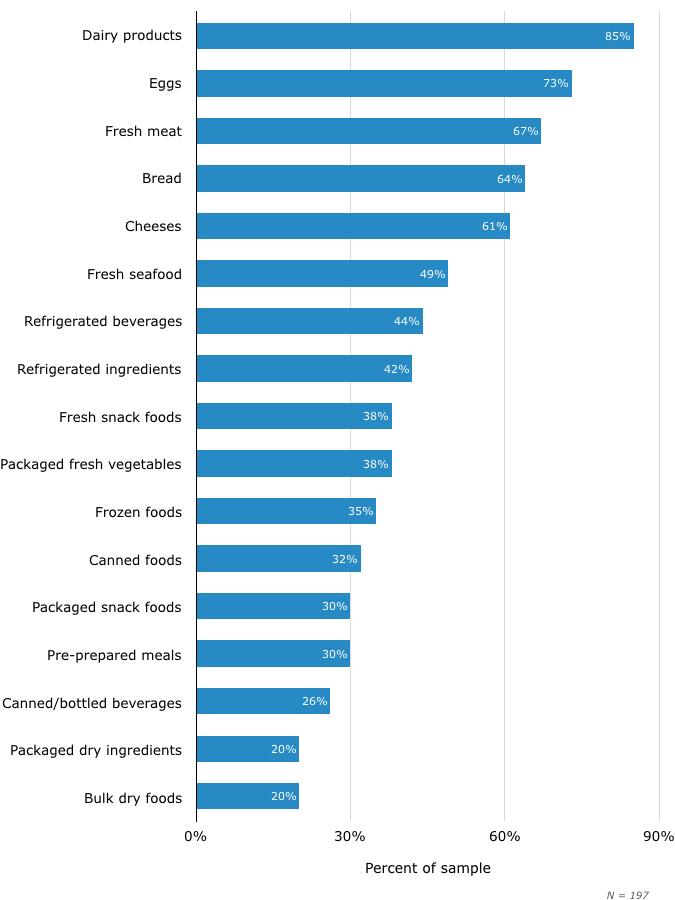
Unsurprisingly, dairy, eggs and fresh meat are all in the top three. Position number four, however, is more surprising: bread, which is examined by over half our sample.
Moldy or stale bread doesn’t pose the same kinds of food safety issues as other types of fresh food. Instead, consumers are attentive to expiration dates on bread because they want it to last as long and taste as fresh as possible.
Cheeses are another food product most consumers plan to keep around for a while. Thus, they’re also closely inspected by over half our sample.
Distributors in the dairy, meat, bread and refrigerated beverage/ingredient industries should therefore consider basic or dynamic FEFO.
Refrigerated beverages, such as smoothies, and refrigerated ingredients, such as tofu, tend to be more heavily scrutinized by consumers than frozen foods. This makes sense, as frozen foods generally have a longer shelf life.
However, frozen food distributors that need end-to-end control over their cold chains will need to explore a dynamic FEFO solution based on wireless sensors.
On the other hand, dry ingredients, bulk dry foods and bottled or canned beverages aren’t very closely inspected by consumers. Distributors focusing on these industries may be able to stick with the FIFO method.
Distributors Selling to Big Groceries/Retailers Can Benefit Most
We also asked respondents about the types of stores where they find expired merchandise:
Retail Locations Where Consumers Find Expired Food
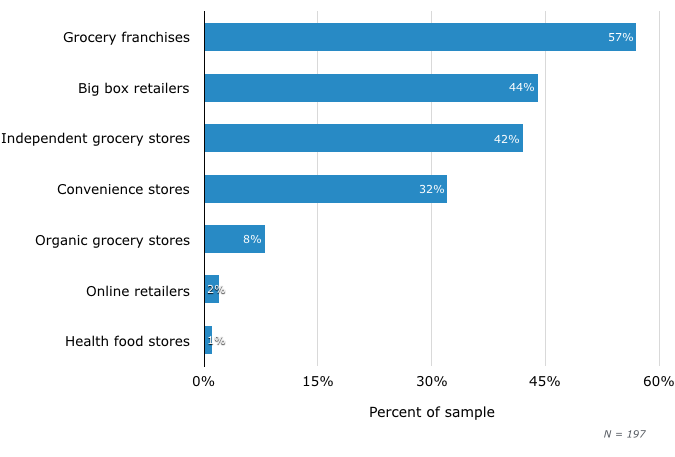
Interestingly, more consumers find expired merchandise at grocery franchises and big box retailers than at independent grocery stores or convenience stores. This may partially reflect consumers’ shopping habits: If consumers shop more frequently at franchises, they’ll be more likely to find more expired food there.
But we can also conclude that FEFO should be a priority for distributors working with larger grocery chains.
Conclusions
Let’s take a quick moment to recap the most important takeaways we’ve covered in this report:
When calculating how much lead time you want the FEFO method to offer, remember that consumers will need at least three to five days of shelf life after purchasing an item.
Prioritize switching to FEFO if you operate in the dairy, meat, bread or seafood industries, or if you’re distributing refrigerated items.
Prioritize switching to FEFO if your retail clients are grocery franchises or “big box” retailers.
Explore dynamic FEFO solutions based on wireless sensors if you need total control over the temperatures to which products are exposed in your cold chain.
Now that we’ve looked at the case for switching to FEFO, you can begin building a short list of the vendors that fit your needs (as well as your budget) using our guide to inventory management and distribution ERP solutions.
The guide is specifically written for distributors, so it identifies vendors that offer expiration date and lot tracking, in addition to offering detailed pricing and licensing information for vendors in this market niche.